TESCO's HRM Challenges: Issues, Theories, and Recommended Solutions
VerifiedAdded on 2023/01/17
|13
|3687
|37
Report
AI Summary
This report provides an in-depth analysis of Human Resource Management (HRM) issues at TESCO, a leading international retailer. It begins with an overview of TESCO's background and then identifies two major HRM problems: job cuts due to cost-cutting measures and allegations of discrimination related to pay rate adjustments. The report critically examines these issues, highlighting the potential negative impacts on employee morale and company image. It then introduces two relevant HRM theories and models, the Guest Model and the Fombrun Model, to provide a framework for resolving these issues. The Guest Model is used to analyze the interrelation of HRM strategy, practices, outcomes, behaviour outcomes, performance outcomes and financial outcomes. The Fombrun model focuses on selection, appraisal, development and rewards. Finally, the report offers recommendations for TESCO to address these challenges and improve its HRM practices, aiming to foster a more positive and equitable work environment while maintaining competitiveness.
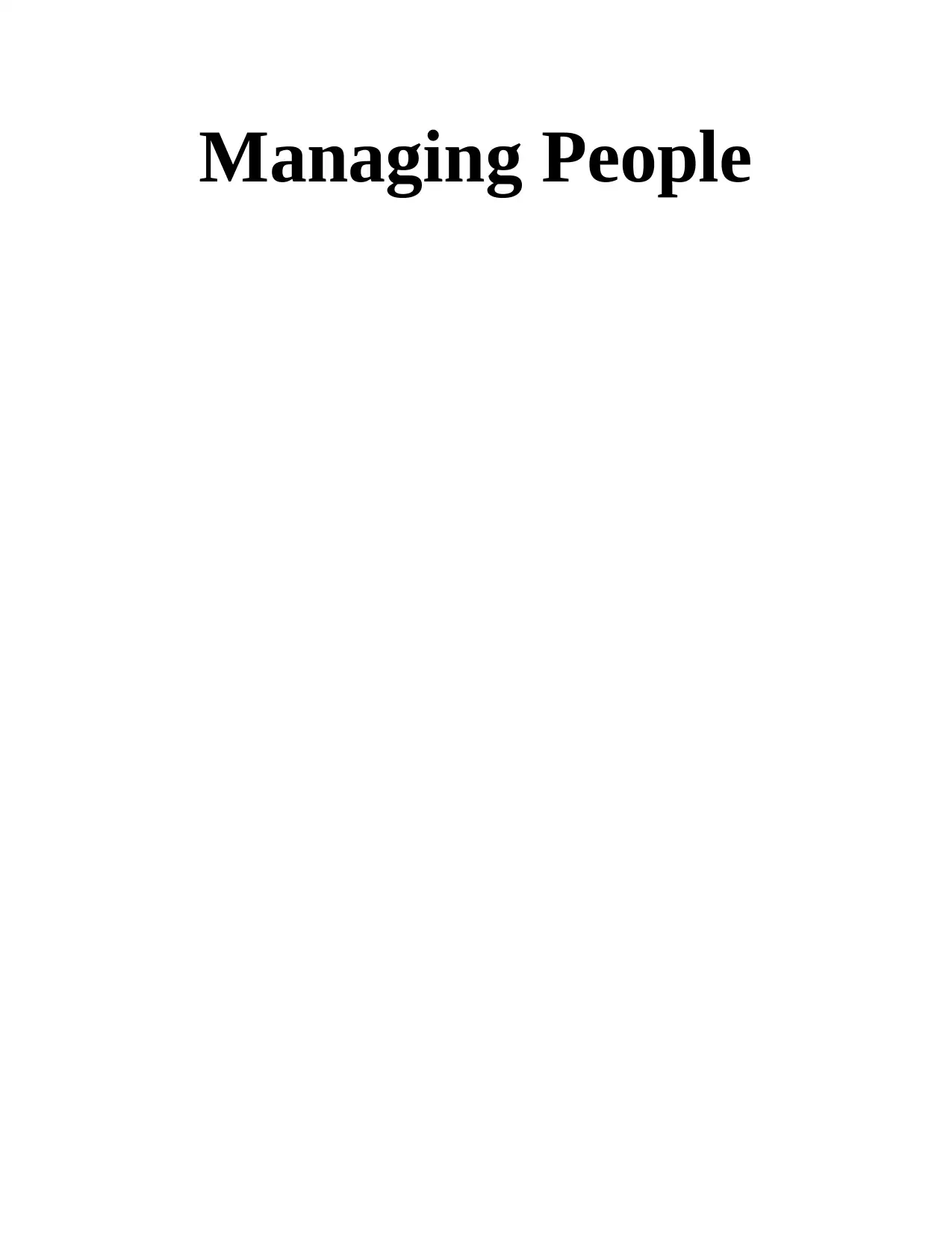
Managing People
Paraphrase This Document
Need a fresh take? Get an instant paraphrase of this document with our AI Paraphraser
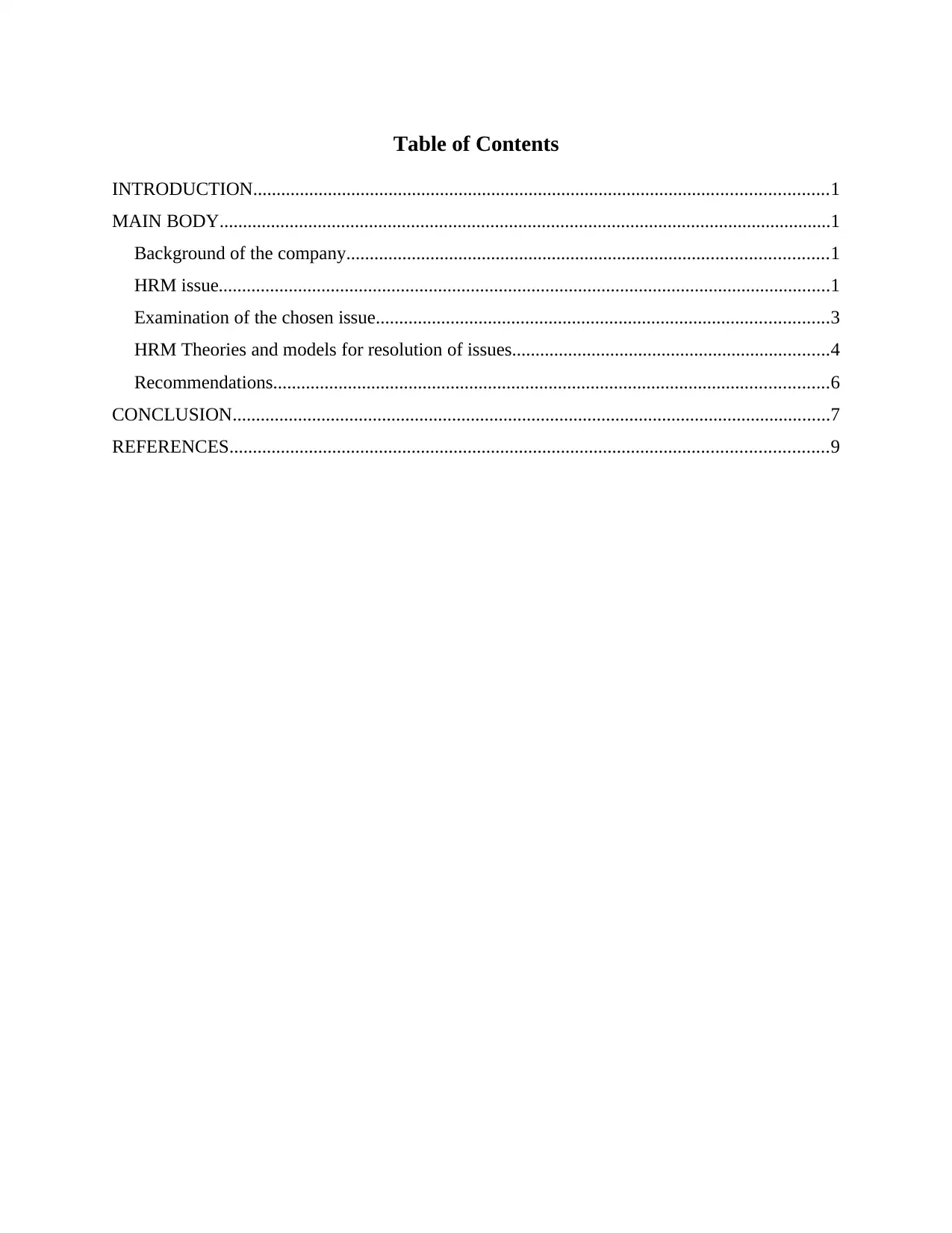
Table of Contents
INTRODUCTION...........................................................................................................................1
MAIN BODY...................................................................................................................................1
Background of the company.......................................................................................................1
HRM issue...................................................................................................................................1
Examination of the chosen issue.................................................................................................3
HRM Theories and models for resolution of issues....................................................................4
Recommendations.......................................................................................................................6
CONCLUSION................................................................................................................................7
REFERENCES................................................................................................................................9
INTRODUCTION...........................................................................................................................1
MAIN BODY...................................................................................................................................1
Background of the company.......................................................................................................1
HRM issue...................................................................................................................................1
Examination of the chosen issue.................................................................................................3
HRM Theories and models for resolution of issues....................................................................4
Recommendations.......................................................................................................................6
CONCLUSION................................................................................................................................7
REFERENCES................................................................................................................................9

⊘ This is a preview!⊘
Do you want full access?
Subscribe today to unlock all pages.

Trusted by 1+ million students worldwide
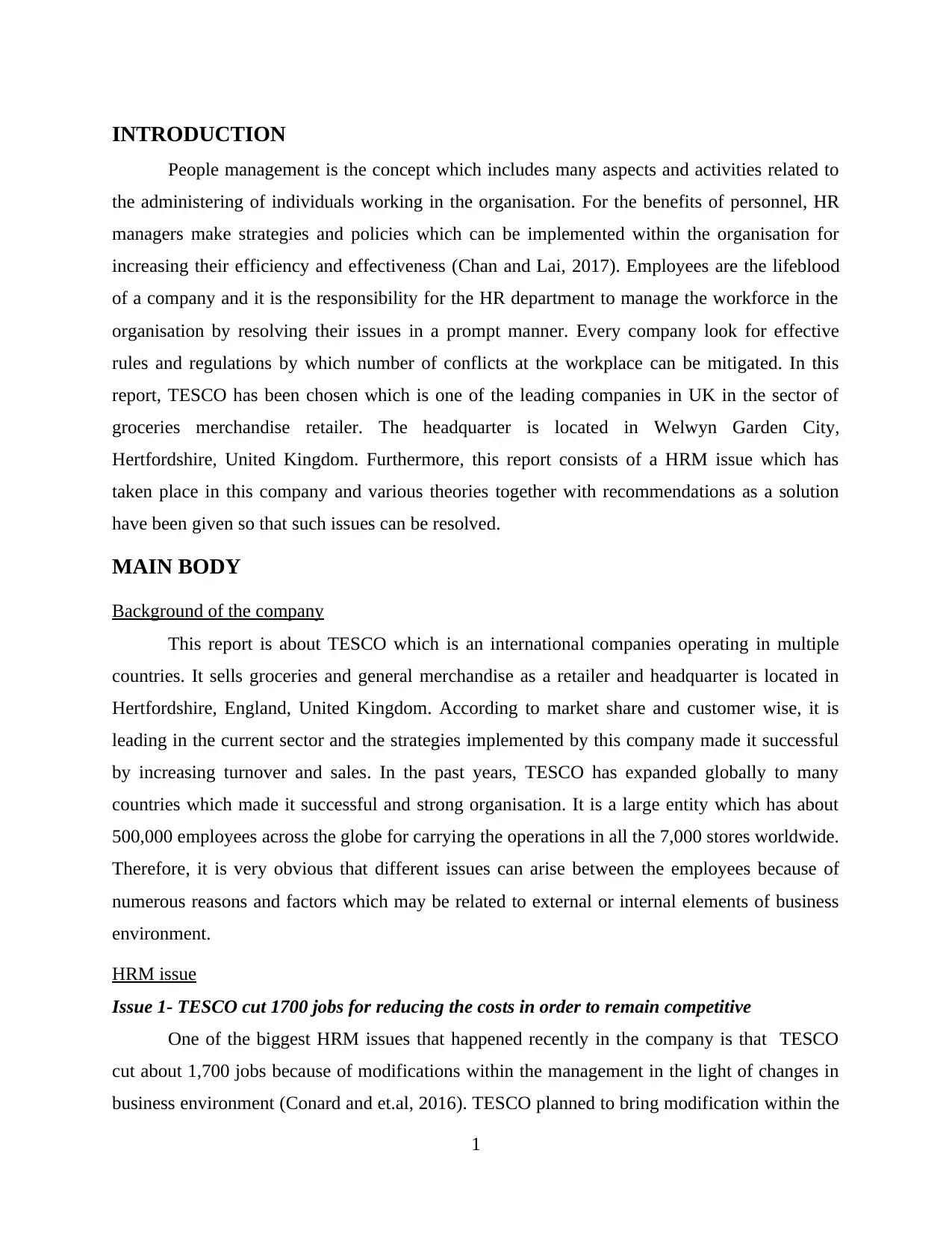
INTRODUCTION
People management is the concept which includes many aspects and activities related to
the administering of individuals working in the organisation. For the benefits of personnel, HR
managers make strategies and policies which can be implemented within the organisation for
increasing their efficiency and effectiveness (Chan and Lai, 2017). Employees are the lifeblood
of a company and it is the responsibility for the HR department to manage the workforce in the
organisation by resolving their issues in a prompt manner. Every company look for effective
rules and regulations by which number of conflicts at the workplace can be mitigated. In this
report, TESCO has been chosen which is one of the leading companies in UK in the sector of
groceries merchandise retailer. The headquarter is located in Welwyn Garden City,
Hertfordshire, United Kingdom. Furthermore, this report consists of a HRM issue which has
taken place in this company and various theories together with recommendations as a solution
have been given so that such issues can be resolved.
MAIN BODY
Background of the company
This report is about TESCO which is an international companies operating in multiple
countries. It sells groceries and general merchandise as a retailer and headquarter is located in
Hertfordshire, England, United Kingdom. According to market share and customer wise, it is
leading in the current sector and the strategies implemented by this company made it successful
by increasing turnover and sales. In the past years, TESCO has expanded globally to many
countries which made it successful and strong organisation. It is a large entity which has about
500,000 employees across the globe for carrying the operations in all the 7,000 stores worldwide.
Therefore, it is very obvious that different issues can arise between the employees because of
numerous reasons and factors which may be related to external or internal elements of business
environment.
HRM issue
Issue 1- TESCO cut 1700 jobs for reducing the costs in order to remain competitive
One of the biggest HRM issues that happened recently in the company is that TESCO
cut about 1,700 jobs because of modifications within the management in the light of changes in
business environment (Conard and et.al, 2016). TESCO planned to bring modification within the
1
People management is the concept which includes many aspects and activities related to
the administering of individuals working in the organisation. For the benefits of personnel, HR
managers make strategies and policies which can be implemented within the organisation for
increasing their efficiency and effectiveness (Chan and Lai, 2017). Employees are the lifeblood
of a company and it is the responsibility for the HR department to manage the workforce in the
organisation by resolving their issues in a prompt manner. Every company look for effective
rules and regulations by which number of conflicts at the workplace can be mitigated. In this
report, TESCO has been chosen which is one of the leading companies in UK in the sector of
groceries merchandise retailer. The headquarter is located in Welwyn Garden City,
Hertfordshire, United Kingdom. Furthermore, this report consists of a HRM issue which has
taken place in this company and various theories together with recommendations as a solution
have been given so that such issues can be resolved.
MAIN BODY
Background of the company
This report is about TESCO which is an international companies operating in multiple
countries. It sells groceries and general merchandise as a retailer and headquarter is located in
Hertfordshire, England, United Kingdom. According to market share and customer wise, it is
leading in the current sector and the strategies implemented by this company made it successful
by increasing turnover and sales. In the past years, TESCO has expanded globally to many
countries which made it successful and strong organisation. It is a large entity which has about
500,000 employees across the globe for carrying the operations in all the 7,000 stores worldwide.
Therefore, it is very obvious that different issues can arise between the employees because of
numerous reasons and factors which may be related to external or internal elements of business
environment.
HRM issue
Issue 1- TESCO cut 1700 jobs for reducing the costs in order to remain competitive
One of the biggest HRM issues that happened recently in the company is that TESCO
cut about 1,700 jobs because of modifications within the management in the light of changes in
business environment (Conard and et.al, 2016). TESCO planned to bring modification within the
1
Paraphrase This Document
Need a fresh take? Get an instant paraphrase of this document with our AI Paraphraser
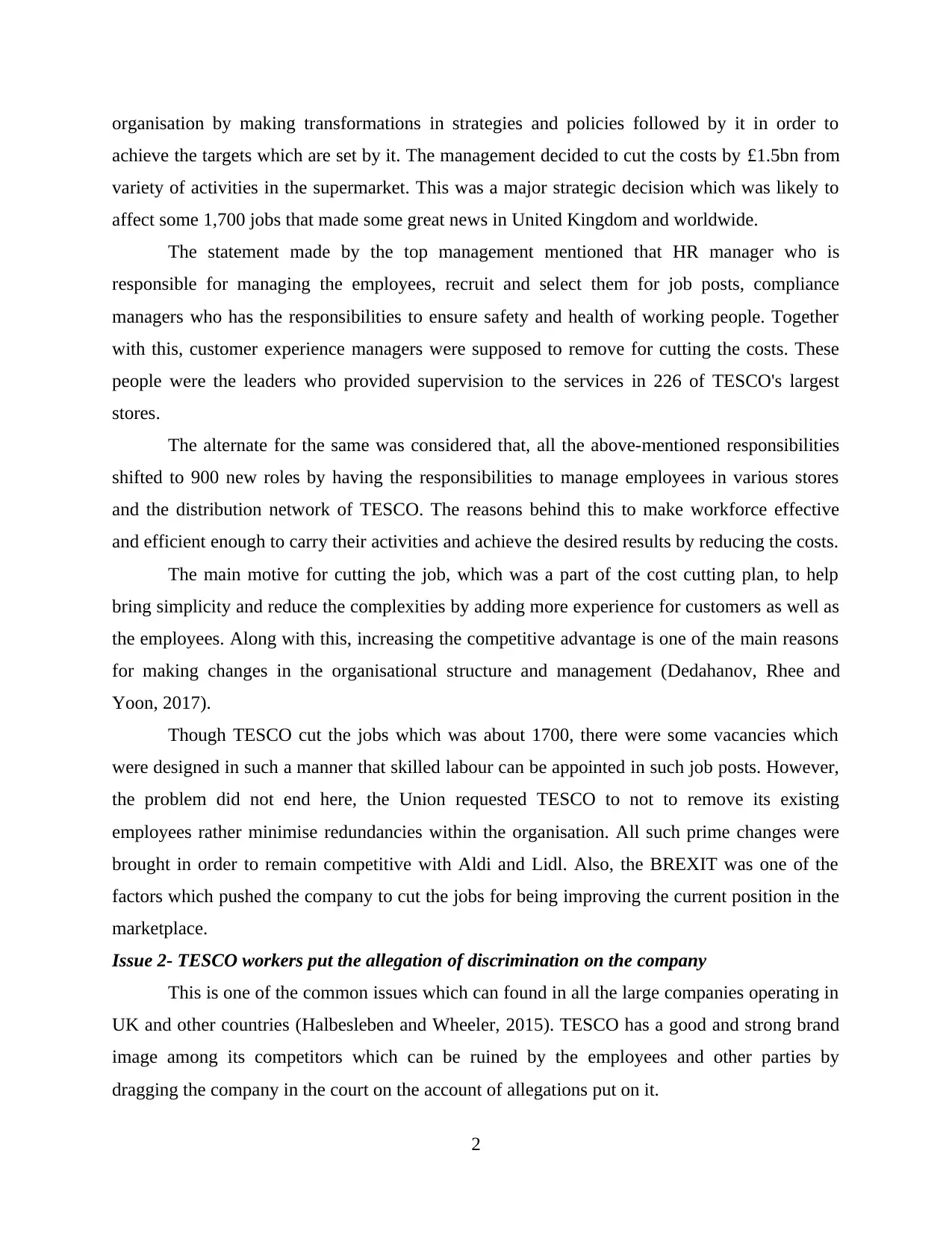
organisation by making transformations in strategies and policies followed by it in order to
achieve the targets which are set by it. The management decided to cut the costs by £1.5bn from
variety of activities in the supermarket. This was a major strategic decision which was likely to
affect some 1,700 jobs that made some great news in United Kingdom and worldwide.
The statement made by the top management mentioned that HR manager who is
responsible for managing the employees, recruit and select them for job posts, compliance
managers who has the responsibilities to ensure safety and health of working people. Together
with this, customer experience managers were supposed to remove for cutting the costs. These
people were the leaders who provided supervision to the services in 226 of TESCO's largest
stores.
The alternate for the same was considered that, all the above-mentioned responsibilities
shifted to 900 new roles by having the responsibilities to manage employees in various stores
and the distribution network of TESCO. The reasons behind this to make workforce effective
and efficient enough to carry their activities and achieve the desired results by reducing the costs.
The main motive for cutting the job, which was a part of the cost cutting plan, to help
bring simplicity and reduce the complexities by adding more experience for customers as well as
the employees. Along with this, increasing the competitive advantage is one of the main reasons
for making changes in the organisational structure and management (Dedahanov, Rhee and
Yoon, 2017).
Though TESCO cut the jobs which was about 1700, there were some vacancies which
were designed in such a manner that skilled labour can be appointed in such job posts. However,
the problem did not end here, the Union requested TESCO to not to remove its existing
employees rather minimise redundancies within the organisation. All such prime changes were
brought in order to remain competitive with Aldi and Lidl. Also, the BREXIT was one of the
factors which pushed the company to cut the jobs for being improving the current position in the
marketplace.
Issue 2- TESCO workers put the allegation of discrimination on the company
This is one of the common issues which can found in all the large companies operating in
UK and other countries (Halbesleben and Wheeler, 2015). TESCO has a good and strong brand
image among its competitors which can be ruined by the employees and other parties by
dragging the company in the court on the account of allegations put on it.
2
achieve the targets which are set by it. The management decided to cut the costs by £1.5bn from
variety of activities in the supermarket. This was a major strategic decision which was likely to
affect some 1,700 jobs that made some great news in United Kingdom and worldwide.
The statement made by the top management mentioned that HR manager who is
responsible for managing the employees, recruit and select them for job posts, compliance
managers who has the responsibilities to ensure safety and health of working people. Together
with this, customer experience managers were supposed to remove for cutting the costs. These
people were the leaders who provided supervision to the services in 226 of TESCO's largest
stores.
The alternate for the same was considered that, all the above-mentioned responsibilities
shifted to 900 new roles by having the responsibilities to manage employees in various stores
and the distribution network of TESCO. The reasons behind this to make workforce effective
and efficient enough to carry their activities and achieve the desired results by reducing the costs.
The main motive for cutting the job, which was a part of the cost cutting plan, to help
bring simplicity and reduce the complexities by adding more experience for customers as well as
the employees. Along with this, increasing the competitive advantage is one of the main reasons
for making changes in the organisational structure and management (Dedahanov, Rhee and
Yoon, 2017).
Though TESCO cut the jobs which was about 1700, there were some vacancies which
were designed in such a manner that skilled labour can be appointed in such job posts. However,
the problem did not end here, the Union requested TESCO to not to remove its existing
employees rather minimise redundancies within the organisation. All such prime changes were
brought in order to remain competitive with Aldi and Lidl. Also, the BREXIT was one of the
factors which pushed the company to cut the jobs for being improving the current position in the
marketplace.
Issue 2- TESCO workers put the allegation of discrimination on the company
This is one of the common issues which can found in all the large companies operating in
UK and other countries (Halbesleben and Wheeler, 2015). TESCO has a good and strong brand
image among its competitors which can be ruined by the employees and other parties by
dragging the company in the court on the account of allegations put on it.
2
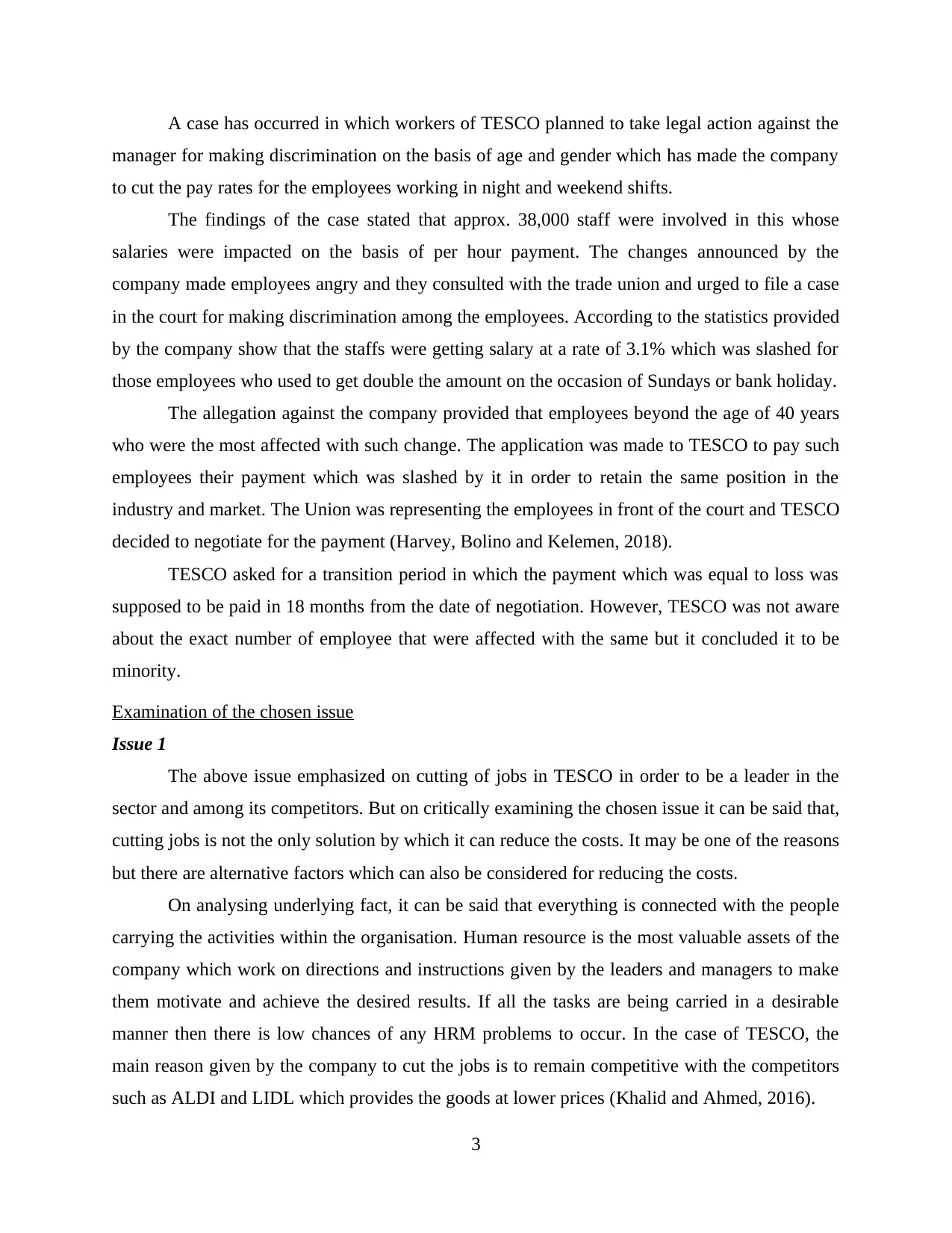
A case has occurred in which workers of TESCO planned to take legal action against the
manager for making discrimination on the basis of age and gender which has made the company
to cut the pay rates for the employees working in night and weekend shifts.
The findings of the case stated that approx. 38,000 staff were involved in this whose
salaries were impacted on the basis of per hour payment. The changes announced by the
company made employees angry and they consulted with the trade union and urged to file a case
in the court for making discrimination among the employees. According to the statistics provided
by the company show that the staffs were getting salary at a rate of 3.1% which was slashed for
those employees who used to get double the amount on the occasion of Sundays or bank holiday.
The allegation against the company provided that employees beyond the age of 40 years
who were the most affected with such change. The application was made to TESCO to pay such
employees their payment which was slashed by it in order to retain the same position in the
industry and market. The Union was representing the employees in front of the court and TESCO
decided to negotiate for the payment (Harvey, Bolino and Kelemen, 2018).
TESCO asked for a transition period in which the payment which was equal to loss was
supposed to be paid in 18 months from the date of negotiation. However, TESCO was not aware
about the exact number of employee that were affected with the same but it concluded it to be
minority.
Examination of the chosen issue
Issue 1
The above issue emphasized on cutting of jobs in TESCO in order to be a leader in the
sector and among its competitors. But on critically examining the chosen issue it can be said that,
cutting jobs is not the only solution by which it can reduce the costs. It may be one of the reasons
but there are alternative factors which can also be considered for reducing the costs.
On analysing underlying fact, it can be said that everything is connected with the people
carrying the activities within the organisation. Human resource is the most valuable assets of the
company which work on directions and instructions given by the leaders and managers to make
them motivate and achieve the desired results. If all the tasks are being carried in a desirable
manner then there is low chances of any HRM problems to occur. In the case of TESCO, the
main reason given by the company to cut the jobs is to remain competitive with the competitors
such as ALDI and LIDL which provides the goods at lower prices (Khalid and Ahmed, 2016).
3
manager for making discrimination on the basis of age and gender which has made the company
to cut the pay rates for the employees working in night and weekend shifts.
The findings of the case stated that approx. 38,000 staff were involved in this whose
salaries were impacted on the basis of per hour payment. The changes announced by the
company made employees angry and they consulted with the trade union and urged to file a case
in the court for making discrimination among the employees. According to the statistics provided
by the company show that the staffs were getting salary at a rate of 3.1% which was slashed for
those employees who used to get double the amount on the occasion of Sundays or bank holiday.
The allegation against the company provided that employees beyond the age of 40 years
who were the most affected with such change. The application was made to TESCO to pay such
employees their payment which was slashed by it in order to retain the same position in the
industry and market. The Union was representing the employees in front of the court and TESCO
decided to negotiate for the payment (Harvey, Bolino and Kelemen, 2018).
TESCO asked for a transition period in which the payment which was equal to loss was
supposed to be paid in 18 months from the date of negotiation. However, TESCO was not aware
about the exact number of employee that were affected with the same but it concluded it to be
minority.
Examination of the chosen issue
Issue 1
The above issue emphasized on cutting of jobs in TESCO in order to be a leader in the
sector and among its competitors. But on critically examining the chosen issue it can be said that,
cutting jobs is not the only solution by which it can reduce the costs. It may be one of the reasons
but there are alternative factors which can also be considered for reducing the costs.
On analysing underlying fact, it can be said that everything is connected with the people
carrying the activities within the organisation. Human resource is the most valuable assets of the
company which work on directions and instructions given by the leaders and managers to make
them motivate and achieve the desired results. If all the tasks are being carried in a desirable
manner then there is low chances of any HRM problems to occur. In the case of TESCO, the
main reason given by the company to cut the jobs is to remain competitive with the competitors
such as ALDI and LIDL which provides the goods at lower prices (Khalid and Ahmed, 2016).
3
⊘ This is a preview!⊘
Do you want full access?
Subscribe today to unlock all pages.

Trusted by 1+ million students worldwide
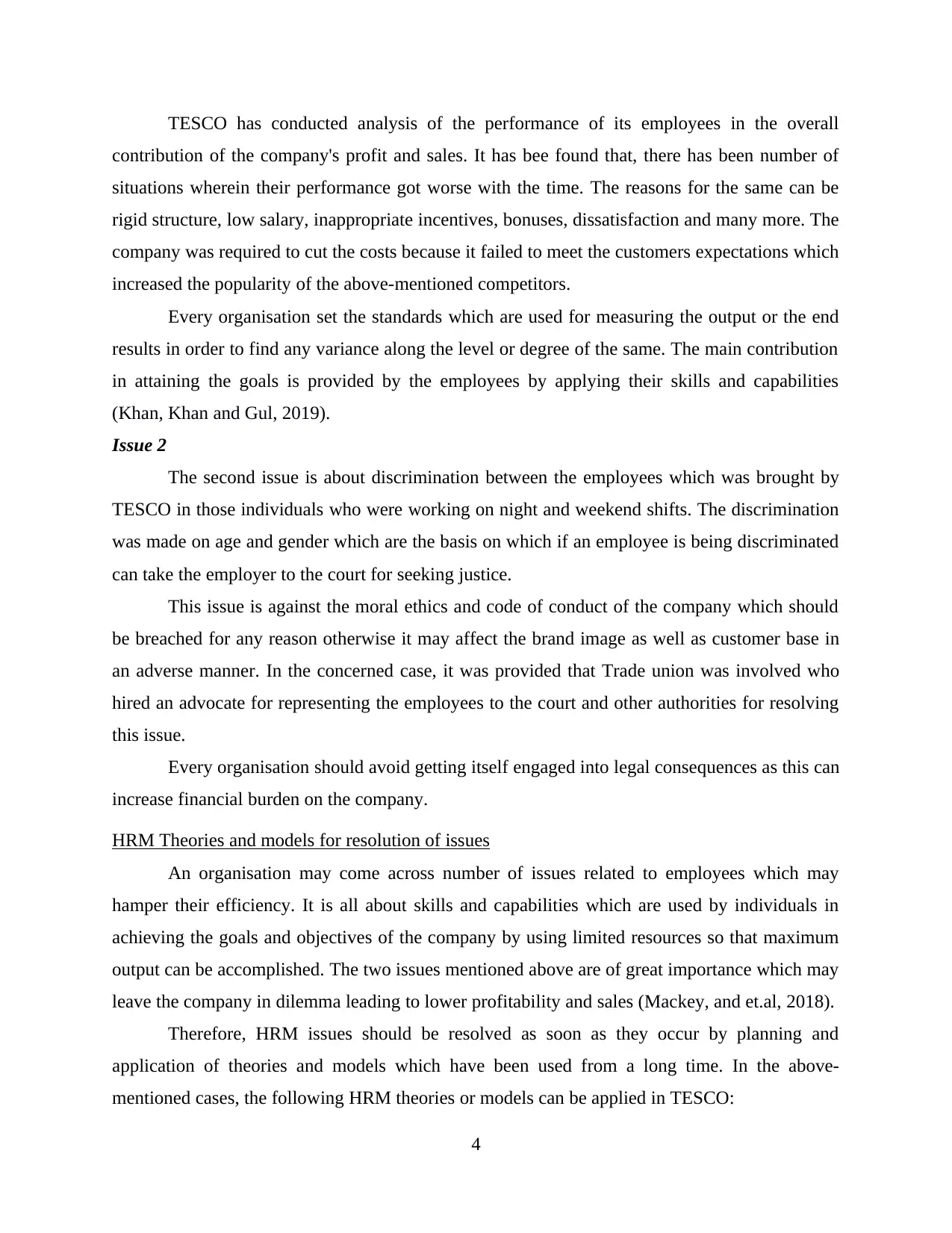
TESCO has conducted analysis of the performance of its employees in the overall
contribution of the company's profit and sales. It has bee found that, there has been number of
situations wherein their performance got worse with the time. The reasons for the same can be
rigid structure, low salary, inappropriate incentives, bonuses, dissatisfaction and many more. The
company was required to cut the costs because it failed to meet the customers expectations which
increased the popularity of the above-mentioned competitors.
Every organisation set the standards which are used for measuring the output or the end
results in order to find any variance along the level or degree of the same. The main contribution
in attaining the goals is provided by the employees by applying their skills and capabilities
(Khan, Khan and Gul, 2019).
Issue 2
The second issue is about discrimination between the employees which was brought by
TESCO in those individuals who were working on night and weekend shifts. The discrimination
was made on age and gender which are the basis on which if an employee is being discriminated
can take the employer to the court for seeking justice.
This issue is against the moral ethics and code of conduct of the company which should
be breached for any reason otherwise it may affect the brand image as well as customer base in
an adverse manner. In the concerned case, it was provided that Trade union was involved who
hired an advocate for representing the employees to the court and other authorities for resolving
this issue.
Every organisation should avoid getting itself engaged into legal consequences as this can
increase financial burden on the company.
HRM Theories and models for resolution of issues
An organisation may come across number of issues related to employees which may
hamper their efficiency. It is all about skills and capabilities which are used by individuals in
achieving the goals and objectives of the company by using limited resources so that maximum
output can be accomplished. The two issues mentioned above are of great importance which may
leave the company in dilemma leading to lower profitability and sales (Mackey, and et.al, 2018).
Therefore, HRM issues should be resolved as soon as they occur by planning and
application of theories and models which have been used from a long time. In the above-
mentioned cases, the following HRM theories or models can be applied in TESCO:
4
contribution of the company's profit and sales. It has bee found that, there has been number of
situations wherein their performance got worse with the time. The reasons for the same can be
rigid structure, low salary, inappropriate incentives, bonuses, dissatisfaction and many more. The
company was required to cut the costs because it failed to meet the customers expectations which
increased the popularity of the above-mentioned competitors.
Every organisation set the standards which are used for measuring the output or the end
results in order to find any variance along the level or degree of the same. The main contribution
in attaining the goals is provided by the employees by applying their skills and capabilities
(Khan, Khan and Gul, 2019).
Issue 2
The second issue is about discrimination between the employees which was brought by
TESCO in those individuals who were working on night and weekend shifts. The discrimination
was made on age and gender which are the basis on which if an employee is being discriminated
can take the employer to the court for seeking justice.
This issue is against the moral ethics and code of conduct of the company which should
be breached for any reason otherwise it may affect the brand image as well as customer base in
an adverse manner. In the concerned case, it was provided that Trade union was involved who
hired an advocate for representing the employees to the court and other authorities for resolving
this issue.
Every organisation should avoid getting itself engaged into legal consequences as this can
increase financial burden on the company.
HRM Theories and models for resolution of issues
An organisation may come across number of issues related to employees which may
hamper their efficiency. It is all about skills and capabilities which are used by individuals in
achieving the goals and objectives of the company by using limited resources so that maximum
output can be accomplished. The two issues mentioned above are of great importance which may
leave the company in dilemma leading to lower profitability and sales (Mackey, and et.al, 2018).
Therefore, HRM issues should be resolved as soon as they occur by planning and
application of theories and models which have been used from a long time. In the above-
mentioned cases, the following HRM theories or models can be applied in TESCO:
4
Paraphrase This Document
Need a fresh take? Get an instant paraphrase of this document with our AI Paraphraser
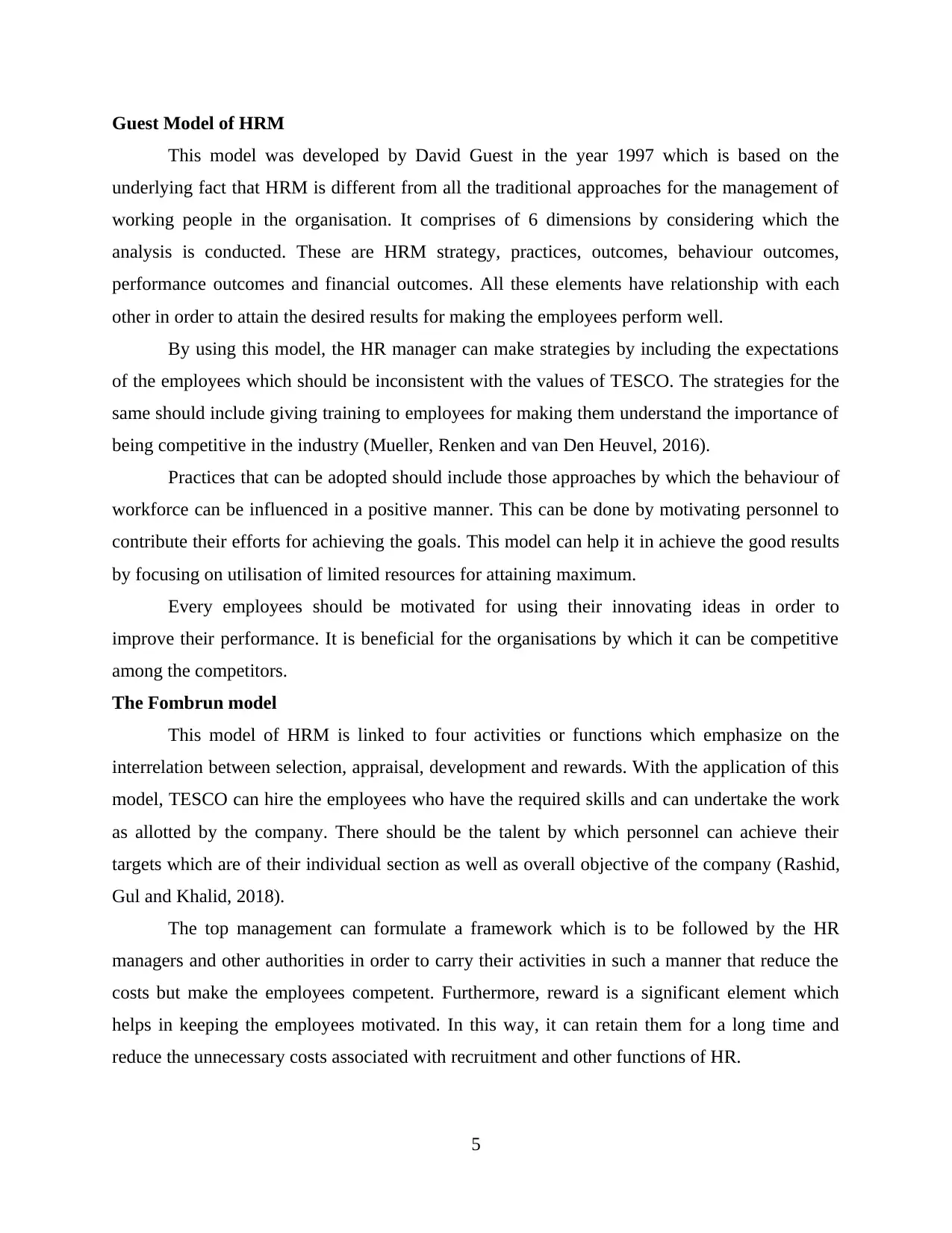
Guest Model of HRM
This model was developed by David Guest in the year 1997 which is based on the
underlying fact that HRM is different from all the traditional approaches for the management of
working people in the organisation. It comprises of 6 dimensions by considering which the
analysis is conducted. These are HRM strategy, practices, outcomes, behaviour outcomes,
performance outcomes and financial outcomes. All these elements have relationship with each
other in order to attain the desired results for making the employees perform well.
By using this model, the HR manager can make strategies by including the expectations
of the employees which should be inconsistent with the values of TESCO. The strategies for the
same should include giving training to employees for making them understand the importance of
being competitive in the industry (Mueller, Renken and van Den Heuvel, 2016).
Practices that can be adopted should include those approaches by which the behaviour of
workforce can be influenced in a positive manner. This can be done by motivating personnel to
contribute their efforts for achieving the goals. This model can help it in achieve the good results
by focusing on utilisation of limited resources for attaining maximum.
Every employees should be motivated for using their innovating ideas in order to
improve their performance. It is beneficial for the organisations by which it can be competitive
among the competitors.
The Fombrun model
This model of HRM is linked to four activities or functions which emphasize on the
interrelation between selection, appraisal, development and rewards. With the application of this
model, TESCO can hire the employees who have the required skills and can undertake the work
as allotted by the company. There should be the talent by which personnel can achieve their
targets which are of their individual section as well as overall objective of the company (Rashid,
Gul and Khalid, 2018).
The top management can formulate a framework which is to be followed by the HR
managers and other authorities in order to carry their activities in such a manner that reduce the
costs but make the employees competent. Furthermore, reward is a significant element which
helps in keeping the employees motivated. In this way, it can retain them for a long time and
reduce the unnecessary costs associated with recruitment and other functions of HR.
5
This model was developed by David Guest in the year 1997 which is based on the
underlying fact that HRM is different from all the traditional approaches for the management of
working people in the organisation. It comprises of 6 dimensions by considering which the
analysis is conducted. These are HRM strategy, practices, outcomes, behaviour outcomes,
performance outcomes and financial outcomes. All these elements have relationship with each
other in order to attain the desired results for making the employees perform well.
By using this model, the HR manager can make strategies by including the expectations
of the employees which should be inconsistent with the values of TESCO. The strategies for the
same should include giving training to employees for making them understand the importance of
being competitive in the industry (Mueller, Renken and van Den Heuvel, 2016).
Practices that can be adopted should include those approaches by which the behaviour of
workforce can be influenced in a positive manner. This can be done by motivating personnel to
contribute their efforts for achieving the goals. This model can help it in achieve the good results
by focusing on utilisation of limited resources for attaining maximum.
Every employees should be motivated for using their innovating ideas in order to
improve their performance. It is beneficial for the organisations by which it can be competitive
among the competitors.
The Fombrun model
This model of HRM is linked to four activities or functions which emphasize on the
interrelation between selection, appraisal, development and rewards. With the application of this
model, TESCO can hire the employees who have the required skills and can undertake the work
as allotted by the company. There should be the talent by which personnel can achieve their
targets which are of their individual section as well as overall objective of the company (Rashid,
Gul and Khalid, 2018).
The top management can formulate a framework which is to be followed by the HR
managers and other authorities in order to carry their activities in such a manner that reduce the
costs but make the employees competent. Furthermore, reward is a significant element which
helps in keeping the employees motivated. In this way, it can retain them for a long time and
reduce the unnecessary costs associated with recruitment and other functions of HR.
5
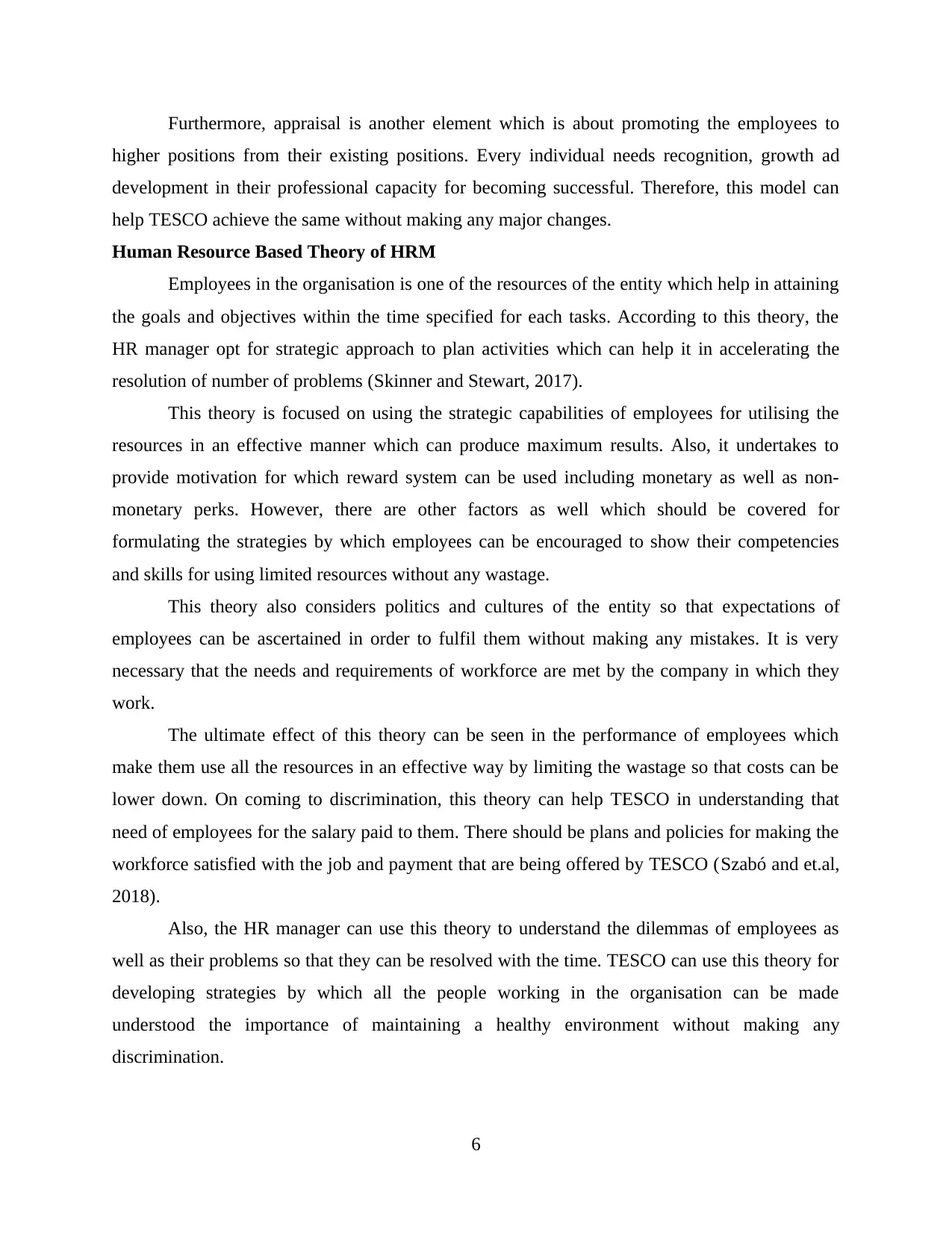
Furthermore, appraisal is another element which is about promoting the employees to
higher positions from their existing positions. Every individual needs recognition, growth ad
development in their professional capacity for becoming successful. Therefore, this model can
help TESCO achieve the same without making any major changes.
Human Resource Based Theory of HRM
Employees in the organisation is one of the resources of the entity which help in attaining
the goals and objectives within the time specified for each tasks. According to this theory, the
HR manager opt for strategic approach to plan activities which can help it in accelerating the
resolution of number of problems (Skinner and Stewart, 2017).
This theory is focused on using the strategic capabilities of employees for utilising the
resources in an effective manner which can produce maximum results. Also, it undertakes to
provide motivation for which reward system can be used including monetary as well as non-
monetary perks. However, there are other factors as well which should be covered for
formulating the strategies by which employees can be encouraged to show their competencies
and skills for using limited resources without any wastage.
This theory also considers politics and cultures of the entity so that expectations of
employees can be ascertained in order to fulfil them without making any mistakes. It is very
necessary that the needs and requirements of workforce are met by the company in which they
work.
The ultimate effect of this theory can be seen in the performance of employees which
make them use all the resources in an effective way by limiting the wastage so that costs can be
lower down. On coming to discrimination, this theory can help TESCO in understanding that
need of employees for the salary paid to them. There should be plans and policies for making the
workforce satisfied with the job and payment that are being offered by TESCO (Szabó and et.al,
2018).
Also, the HR manager can use this theory to understand the dilemmas of employees as
well as their problems so that they can be resolved with the time. TESCO can use this theory for
developing strategies by which all the people working in the organisation can be made
understood the importance of maintaining a healthy environment without making any
discrimination.
6
higher positions from their existing positions. Every individual needs recognition, growth ad
development in their professional capacity for becoming successful. Therefore, this model can
help TESCO achieve the same without making any major changes.
Human Resource Based Theory of HRM
Employees in the organisation is one of the resources of the entity which help in attaining
the goals and objectives within the time specified for each tasks. According to this theory, the
HR manager opt for strategic approach to plan activities which can help it in accelerating the
resolution of number of problems (Skinner and Stewart, 2017).
This theory is focused on using the strategic capabilities of employees for utilising the
resources in an effective manner which can produce maximum results. Also, it undertakes to
provide motivation for which reward system can be used including monetary as well as non-
monetary perks. However, there are other factors as well which should be covered for
formulating the strategies by which employees can be encouraged to show their competencies
and skills for using limited resources without any wastage.
This theory also considers politics and cultures of the entity so that expectations of
employees can be ascertained in order to fulfil them without making any mistakes. It is very
necessary that the needs and requirements of workforce are met by the company in which they
work.
The ultimate effect of this theory can be seen in the performance of employees which
make them use all the resources in an effective way by limiting the wastage so that costs can be
lower down. On coming to discrimination, this theory can help TESCO in understanding that
need of employees for the salary paid to them. There should be plans and policies for making the
workforce satisfied with the job and payment that are being offered by TESCO (Szabó and et.al,
2018).
Also, the HR manager can use this theory to understand the dilemmas of employees as
well as their problems so that they can be resolved with the time. TESCO can use this theory for
developing strategies by which all the people working in the organisation can be made
understood the importance of maintaining a healthy environment without making any
discrimination.
6
⊘ This is a preview!⊘
Do you want full access?
Subscribe today to unlock all pages.

Trusted by 1+ million students worldwide
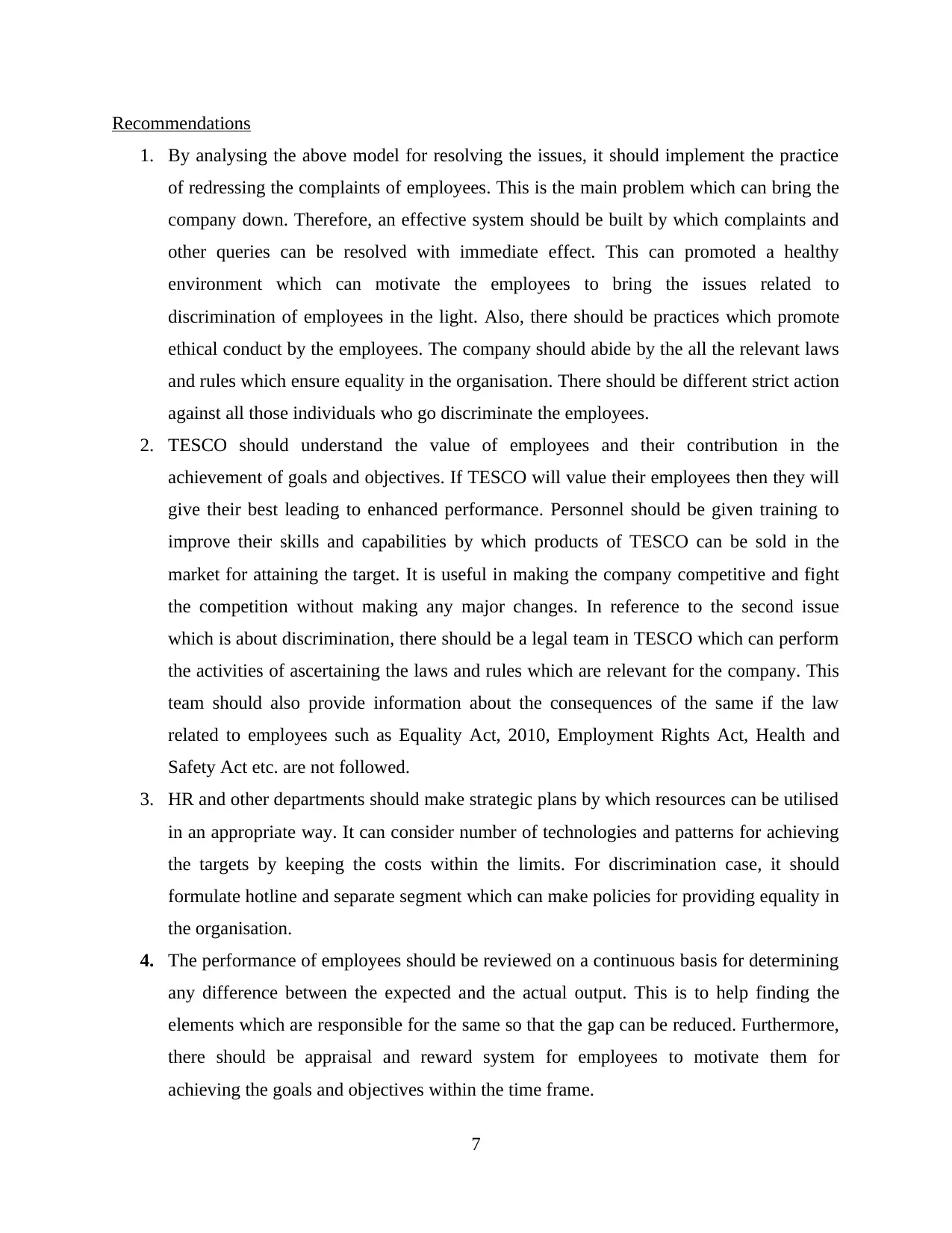
Recommendations
1. By analysing the above model for resolving the issues, it should implement the practice
of redressing the complaints of employees. This is the main problem which can bring the
company down. Therefore, an effective system should be built by which complaints and
other queries can be resolved with immediate effect. This can promoted a healthy
environment which can motivate the employees to bring the issues related to
discrimination of employees in the light. Also, there should be practices which promote
ethical conduct by the employees. The company should abide by the all the relevant laws
and rules which ensure equality in the organisation. There should be different strict action
against all those individuals who go discriminate the employees.
2. TESCO should understand the value of employees and their contribution in the
achievement of goals and objectives. If TESCO will value their employees then they will
give their best leading to enhanced performance. Personnel should be given training to
improve their skills and capabilities by which products of TESCO can be sold in the
market for attaining the target. It is useful in making the company competitive and fight
the competition without making any major changes. In reference to the second issue
which is about discrimination, there should be a legal team in TESCO which can perform
the activities of ascertaining the laws and rules which are relevant for the company. This
team should also provide information about the consequences of the same if the law
related to employees such as Equality Act, 2010, Employment Rights Act, Health and
Safety Act etc. are not followed.
3. HR and other departments should make strategic plans by which resources can be utilised
in an appropriate way. It can consider number of technologies and patterns for achieving
the targets by keeping the costs within the limits. For discrimination case, it should
formulate hotline and separate segment which can make policies for providing equality in
the organisation.
4. The performance of employees should be reviewed on a continuous basis for determining
any difference between the expected and the actual output. This is to help finding the
elements which are responsible for the same so that the gap can be reduced. Furthermore,
there should be appraisal and reward system for employees to motivate them for
achieving the goals and objectives within the time frame.
7
1. By analysing the above model for resolving the issues, it should implement the practice
of redressing the complaints of employees. This is the main problem which can bring the
company down. Therefore, an effective system should be built by which complaints and
other queries can be resolved with immediate effect. This can promoted a healthy
environment which can motivate the employees to bring the issues related to
discrimination of employees in the light. Also, there should be practices which promote
ethical conduct by the employees. The company should abide by the all the relevant laws
and rules which ensure equality in the organisation. There should be different strict action
against all those individuals who go discriminate the employees.
2. TESCO should understand the value of employees and their contribution in the
achievement of goals and objectives. If TESCO will value their employees then they will
give their best leading to enhanced performance. Personnel should be given training to
improve their skills and capabilities by which products of TESCO can be sold in the
market for attaining the target. It is useful in making the company competitive and fight
the competition without making any major changes. In reference to the second issue
which is about discrimination, there should be a legal team in TESCO which can perform
the activities of ascertaining the laws and rules which are relevant for the company. This
team should also provide information about the consequences of the same if the law
related to employees such as Equality Act, 2010, Employment Rights Act, Health and
Safety Act etc. are not followed.
3. HR and other departments should make strategic plans by which resources can be utilised
in an appropriate way. It can consider number of technologies and patterns for achieving
the targets by keeping the costs within the limits. For discrimination case, it should
formulate hotline and separate segment which can make policies for providing equality in
the organisation.
4. The performance of employees should be reviewed on a continuous basis for determining
any difference between the expected and the actual output. This is to help finding the
elements which are responsible for the same so that the gap can be reduced. Furthermore,
there should be appraisal and reward system for employees to motivate them for
achieving the goals and objectives within the time frame.
7
Paraphrase This Document
Need a fresh take? Get an instant paraphrase of this document with our AI Paraphraser
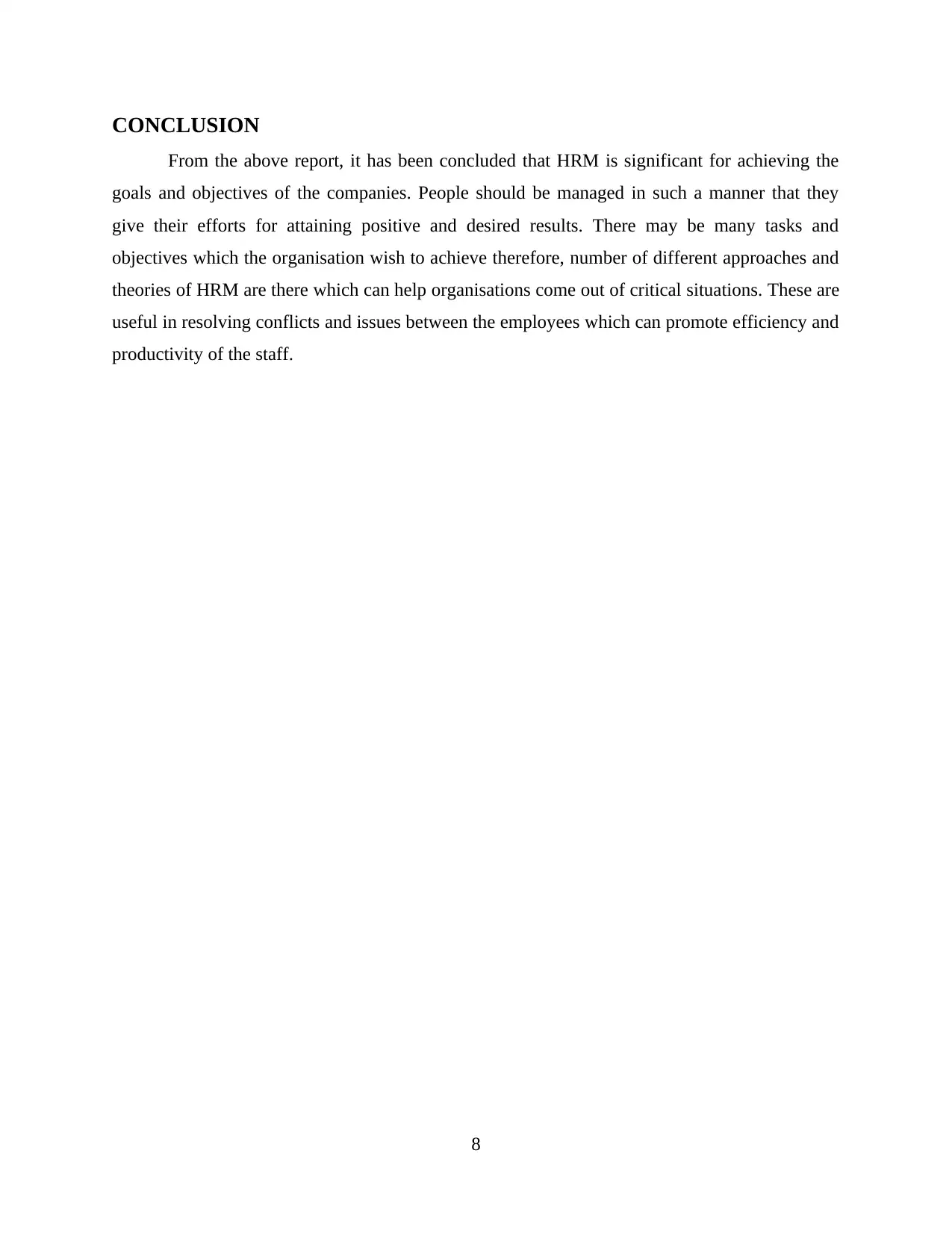
CONCLUSION
From the above report, it has been concluded that HRM is significant for achieving the
goals and objectives of the companies. People should be managed in such a manner that they
give their efforts for attaining positive and desired results. There may be many tasks and
objectives which the organisation wish to achieve therefore, number of different approaches and
theories of HRM are there which can help organisations come out of critical situations. These are
useful in resolving conflicts and issues between the employees which can promote efficiency and
productivity of the staff.
8
From the above report, it has been concluded that HRM is significant for achieving the
goals and objectives of the companies. People should be managed in such a manner that they
give their efforts for attaining positive and desired results. There may be many tasks and
objectives which the organisation wish to achieve therefore, number of different approaches and
theories of HRM are there which can help organisations come out of critical situations. These are
useful in resolving conflicts and issues between the employees which can promote efficiency and
productivity of the staff.
8
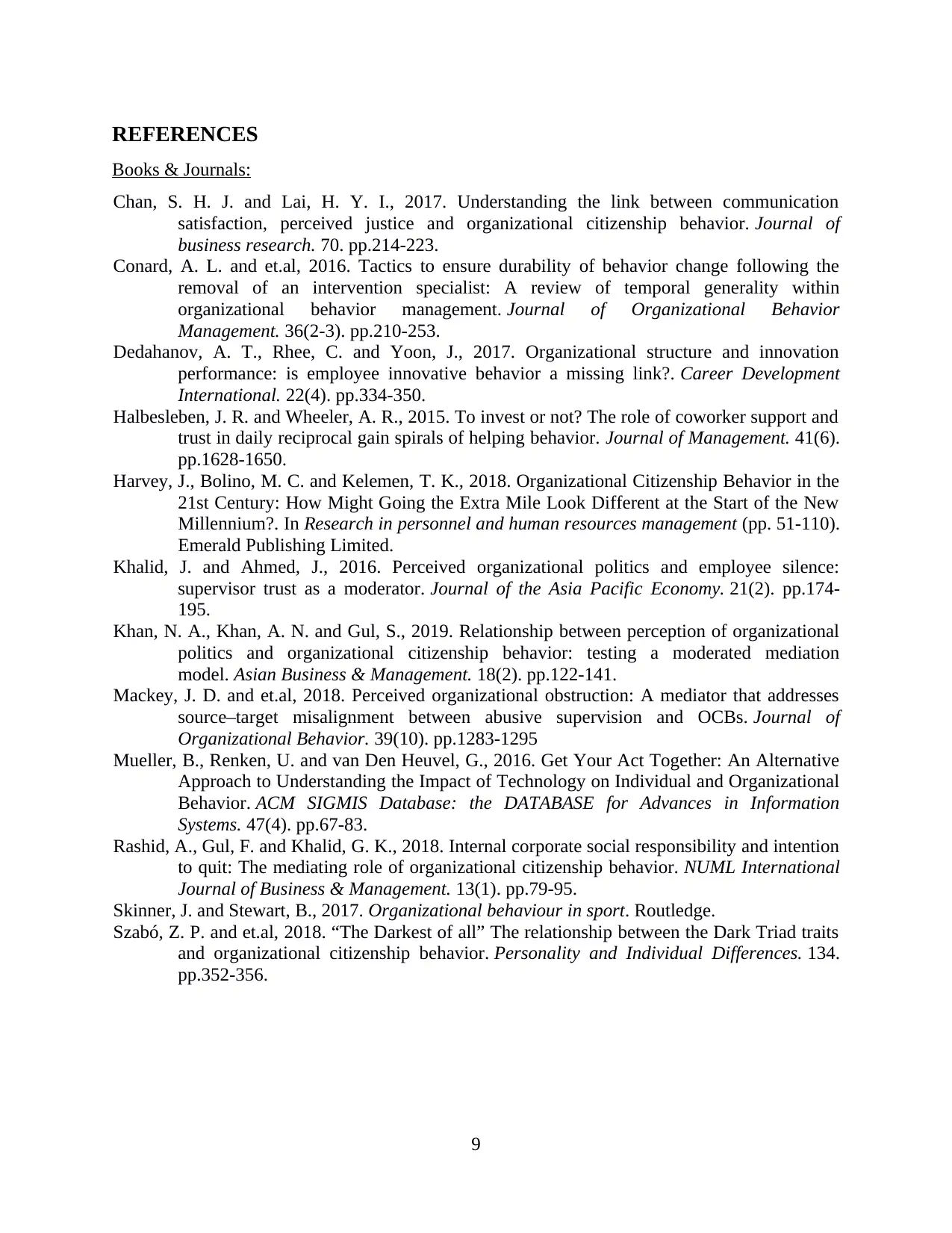
REFERENCES
Books & Journals:
Chan, S. H. J. and Lai, H. Y. I., 2017. Understanding the link between communication
satisfaction, perceived justice and organizational citizenship behavior. Journal of
business research. 70. pp.214-223.
Conard, A. L. and et.al, 2016. Tactics to ensure durability of behavior change following the
removal of an intervention specialist: A review of temporal generality within
organizational behavior management. Journal of Organizational Behavior
Management. 36(2-3). pp.210-253.
Dedahanov, A. T., Rhee, C. and Yoon, J., 2017. Organizational structure and innovation
performance: is employee innovative behavior a missing link?. Career Development
International. 22(4). pp.334-350.
Halbesleben, J. R. and Wheeler, A. R., 2015. To invest or not? The role of coworker support and
trust in daily reciprocal gain spirals of helping behavior. Journal of Management. 41(6).
pp.1628-1650.
Harvey, J., Bolino, M. C. and Kelemen, T. K., 2018. Organizational Citizenship Behavior in the
21st Century: How Might Going the Extra Mile Look Different at the Start of the New
Millennium?. In Research in personnel and human resources management (pp. 51-110).
Emerald Publishing Limited.
Khalid, J. and Ahmed, J., 2016. Perceived organizational politics and employee silence:
supervisor trust as a moderator. Journal of the Asia Pacific Economy. 21(2). pp.174-
195.
Khan, N. A., Khan, A. N. and Gul, S., 2019. Relationship between perception of organizational
politics and organizational citizenship behavior: testing a moderated mediation
model. Asian Business & Management. 18(2). pp.122-141.
Mackey, J. D. and et.al, 2018. Perceived organizational obstruction: A mediator that addresses
source–target misalignment between abusive supervision and OCBs. Journal of
Organizational Behavior. 39(10). pp.1283-1295
Mueller, B., Renken, U. and van Den Heuvel, G., 2016. Get Your Act Together: An Alternative
Approach to Understanding the Impact of Technology on Individual and Organizational
Behavior. ACM SIGMIS Database: the DATABASE for Advances in Information
Systems. 47(4). pp.67-83.
Rashid, A., Gul, F. and Khalid, G. K., 2018. Internal corporate social responsibility and intention
to quit: The mediating role of organizational citizenship behavior. NUML International
Journal of Business & Management. 13(1). pp.79-95.
Skinner, J. and Stewart, B., 2017. Organizational behaviour in sport. Routledge.
Szabó, Z. P. and et.al, 2018. “The Darkest of all” The relationship between the Dark Triad traits
and organizational citizenship behavior. Personality and Individual Differences. 134.
pp.352-356.
9
Books & Journals:
Chan, S. H. J. and Lai, H. Y. I., 2017. Understanding the link between communication
satisfaction, perceived justice and organizational citizenship behavior. Journal of
business research. 70. pp.214-223.
Conard, A. L. and et.al, 2016. Tactics to ensure durability of behavior change following the
removal of an intervention specialist: A review of temporal generality within
organizational behavior management. Journal of Organizational Behavior
Management. 36(2-3). pp.210-253.
Dedahanov, A. T., Rhee, C. and Yoon, J., 2017. Organizational structure and innovation
performance: is employee innovative behavior a missing link?. Career Development
International. 22(4). pp.334-350.
Halbesleben, J. R. and Wheeler, A. R., 2015. To invest or not? The role of coworker support and
trust in daily reciprocal gain spirals of helping behavior. Journal of Management. 41(6).
pp.1628-1650.
Harvey, J., Bolino, M. C. and Kelemen, T. K., 2018. Organizational Citizenship Behavior in the
21st Century: How Might Going the Extra Mile Look Different at the Start of the New
Millennium?. In Research in personnel and human resources management (pp. 51-110).
Emerald Publishing Limited.
Khalid, J. and Ahmed, J., 2016. Perceived organizational politics and employee silence:
supervisor trust as a moderator. Journal of the Asia Pacific Economy. 21(2). pp.174-
195.
Khan, N. A., Khan, A. N. and Gul, S., 2019. Relationship between perception of organizational
politics and organizational citizenship behavior: testing a moderated mediation
model. Asian Business & Management. 18(2). pp.122-141.
Mackey, J. D. and et.al, 2018. Perceived organizational obstruction: A mediator that addresses
source–target misalignment between abusive supervision and OCBs. Journal of
Organizational Behavior. 39(10). pp.1283-1295
Mueller, B., Renken, U. and van Den Heuvel, G., 2016. Get Your Act Together: An Alternative
Approach to Understanding the Impact of Technology on Individual and Organizational
Behavior. ACM SIGMIS Database: the DATABASE for Advances in Information
Systems. 47(4). pp.67-83.
Rashid, A., Gul, F. and Khalid, G. K., 2018. Internal corporate social responsibility and intention
to quit: The mediating role of organizational citizenship behavior. NUML International
Journal of Business & Management. 13(1). pp.79-95.
Skinner, J. and Stewart, B., 2017. Organizational behaviour in sport. Routledge.
Szabó, Z. P. and et.al, 2018. “The Darkest of all” The relationship between the Dark Triad traits
and organizational citizenship behavior. Personality and Individual Differences. 134.
pp.352-356.
9
⊘ This is a preview!⊘
Do you want full access?
Subscribe today to unlock all pages.

Trusted by 1+ million students worldwide
1 out of 13
Related Documents
Your All-in-One AI-Powered Toolkit for Academic Success.
+13062052269
info@desklib.com
Available 24*7 on WhatsApp / Email
![[object Object]](/_next/static/media/star-bottom.7253800d.svg)
Unlock your academic potential
Copyright © 2020–2025 A2Z Services. All Rights Reserved. Developed and managed by ZUCOL.





